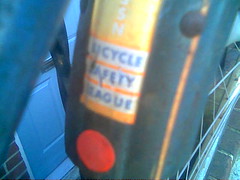 Image by tps12 via Flickr
Image by tps12 via Flickr
Tuesday, July 7, 2009
Making Salem Saturday Market even cooler
Post-Peak Remodeling: What do we do with all those garages
 Image by riebschlager via Flickr
Image by riebschlager via Flickr
Picture a block where 8 neighbors repurpose their garages:
- Garage #1:The Gym. Drawing from neighbors' existing equipment, put in the stationary bike, a treadmill, an elliptical machine or two, weights, and so on, and give everyone access during reasonable hours. Cancel your gym memberships and save some money, too.
- Garage #2: The Music Room. Soundproof the heck out of one garage, roll in a piano, put in a drum set, and a disco ball, and the neighborhood garage bands will be off and rockin'. Sometimes open the garage door and have a dance party in the driveway.
- Garage #3: The Workshop. Consolidate tools, workbenches, and other useful items into one garage. Be sure to carefully label everything or take inventory so you don't forget whose tools are whose. All neighbors can come to repair broken household items, or do wood working projects.
- Garage #4: The Rec Room. Give it a cozy feel with some carpeting and couches, fill it with toys, games, and a ping pong table, and let the fun begin!
- Garage #5: Art Studio. This would be a place for folks to share art supplies, spread out with their art projects, and store their works in progress.
- Garage #6: Stuff Library. This is where you store that one neighborhood lawn mower, and any other items that neighbors are willing to lend to each other - bread machines, sewing machines, camping gear, volleyball net, and so on.
- Garage #7: Dry Goods "Store." Neighbors who want to save money could make bulk orders together and store goods in once place, and maybe come up with a ticket system for dividing expenses. For example, neighbors could buy 500 rolls of [recycled] toilet paper and store them in Garage #7. Each time a neighbor needs to stock up, he or she can go in the garage, "pay" 4 tickets per roll, and take home what is needed. It's like having an informal grocery cooperative on your own block.
- Garage #8: The Library. Carefully label your books and DVDs and shelve them here. Come up with a system for checking items out. Add a couch or two, and the library becomes a quiet place for anyone to come, relax, and get lost in book land.
Decoding the Ethanol Scam and CBO Coverup
 Image by Mike Licht, NotionsCapital.com via Flickr
Image by Mike Licht, NotionsCapital.com via Flickr
Yep, its responsible for a fifth of our high food inflation rate. That percentage translates to roughly [$]9 billion in higher food costs for all Americans. That is well over twice the money spent on ethanol blending subsidies (45 cents for every gallon of ethanol) and about the same as the cost to consumers ([$]9 billion) due to ethanol's lower gas mileage. Together, those costs are about [$]22 billion. The CBO is downplaying the fact that it is costing us [$]9 billion by expressing it as a percentage of a confusing percentage.Update: Excellent dissection of a cellulosic ethanol scam that snagged one of the country's biggest ethanomaniacs here.
It is a reality that ethanol has had an impact on American food prices, exactly how much is debateable, but that impact pales in comparison to the impact in third world countries that rely on our corn exports where people survive on ground corn. Average monthly corn prices remain about 100% higher than historic averages (almost $4.00 a bushel versus $2.00). Those high corn prices have driven some poultry producers into bankruptcy.
Labels:
Food industry,
Politics,
Transport,
Trouble,
Warnings
Subscribe to:
Comments (Atom)

![Reblog this post [with Zemanta]](http://img.zemanta.com/reblog_e.png?x-id=523bc6a6-d0cc-46c0-b48b-4c6a2e03203d)
![Reblog this post [with Zemanta]](http://img.zemanta.com/reblog_e.png?x-id=e22b1746-973c-4ed6-80ae-6cbe5c28a2a7)
![Reblog this post [with Zemanta]](http://img.zemanta.com/reblog_e.png?x-id=14292f2d-d79f-488a-9b8c-05253505f5e4)



